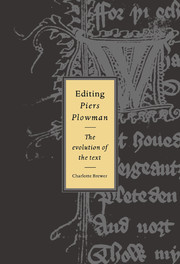Book contents
- Frontmatter
- Contents
- Acknowledgements
- Abbreviations
- Note on the texts
- Introduction
- Part I The early phase
- Part II The late nineteenth century
- 5 The Early English Text Society and its editorial context
- 6 Skeat: introduction
- 7 Skeat's A-Text
- 8 Skeat's B-Text
- 9 Skeat's C-Text
- Part III The Skeat aftermath
- Part IV Chambers and Grattan, Knott and Fowler
- Part V The Athlone Press edition
- Part VI Epilogue: the Athlone aftermath: Schmidt, Pearsall, Rigg-Brewer, et al.
- Works cited
- General index
- Index of manuscripts
- CAMBRIDGE STUDIES IN MEDIEVAL LITERATURE
8 - Skeat's B-Text
Published online by Cambridge University Press: 20 August 2009
- Frontmatter
- Contents
- Acknowledgements
- Abbreviations
- Note on the texts
- Introduction
- Part I The early phase
- Part II The late nineteenth century
- 5 The Early English Text Society and its editorial context
- 6 Skeat: introduction
- 7 Skeat's A-Text
- 8 Skeat's B-Text
- 9 Skeat's C-Text
- Part III The Skeat aftermath
- Part IV Chambers and Grattan, Knott and Fowler
- Part V The Athlone Press edition
- Part VI Epilogue: the Athlone aftermath: Schmidt, Pearsall, Rigg-Brewer, et al.
- Works cited
- General index
- Index of manuscripts
- CAMBRIDGE STUDIES IN MEDIEVAL LITERATURE
Summary
New manuscripts continued to turn up. By the time Skeat published his B-Text in 1869 he had discovered two more copies of Piers Plowman in Oxford, an A-MS and a B-MS, both identified during the process of re-cataloguing the Rawlinson collection in Bodley, and had been supplied with further information about the A-MS in Trinity College Dublin, of whose existence he learned just before the publication of his edition of A.
The interesting thing, of course, is to see how Skeat absorbs new information. He welcomed the discovery of the Rawlinson A-MS (p. 124 above) because it bore further witness to the extra twelfth passus hitherto found only in the University College A-MS (U), and he read the rest of the manuscript carefully enough to realise that it had a close textual relationship with U. This was signalled by the fact that both manuscripts have the same misordering of material (part of Passus VII occurring in Passus I). When Skeat went on to compare details of their readings, he found they often agreed in variants found in no other manuscripts; and for this reason he assumed that they shared a common exemplar. Skeat did not, however, comb through the Rawlinson A-MS's text in order to search out possible original readings – not surprisingly, since he had not done this with any of the other manuscripts.
The other manuscript of the A-Text which Skeat had come across, the manuscript in Dublin to which he assigned the sigil E, seems to have been first identified by Sir Frederick Madden.
- Type
- Chapter
- Information
- Editing Piers PlowmanThe Evolution of the Text, pp. 137 - 158Publisher: Cambridge University PressPrint publication year: 1996

